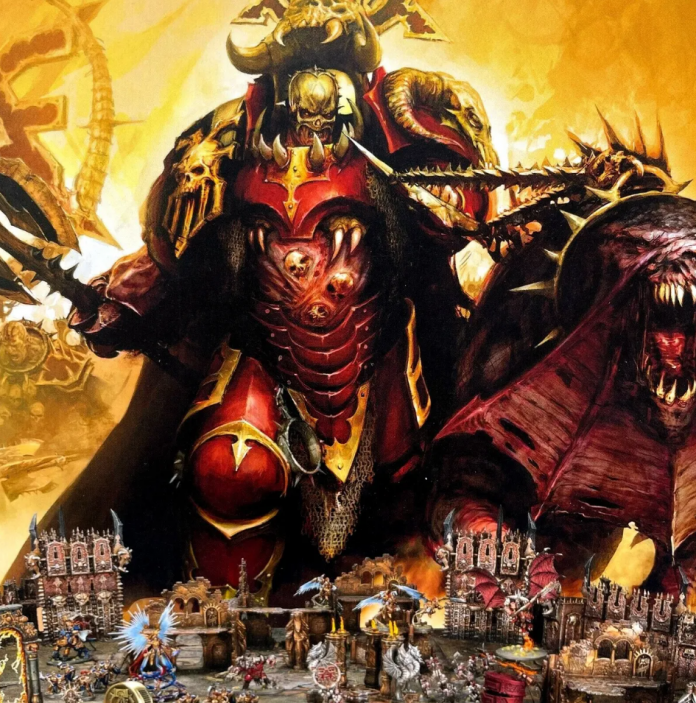As Sigmar’s great work neared completion, he turned back to the realms and saw that the dominion of Chaos was almost complete. The hour for vengeance had come.

Since my last dive into the history of the Mortal Realms’ 1st Edition, quite a lot has changed in Age of Sigmar. Critically, we’re seeing that 4th Edition is unlike any of its previous iterations, taking quite a few cues from Warhammer 40k 10th Edition, and moreover, there’s been massive culls for models across each Grand Alliance. Among them are my beloved Beasts of Chaos, something I didn’t think was possible, but after researching the tumult that propelled Age of Sigmar into the tabletop market, there’s little now that truly surprises me. In brief, I’m heartbroken, and the thought of just one more year playing Beasts in 4th, while the Sword of Damocles lurches ever downward, pains me to no end. In spite of that melancholy, turning back the clock to Age of Sigmar 1.0’s middle years brings us to a time of reevaluation, evolution, and crucially, newfound identity.
The General’s Handbook Era: July 21st, 2016 – August 8th, 2017
We left off on a precipice — July 21st, 2016. This was the launch date for the first ever General’s Handbook in Age of Sigmar, which would become a regularly published series of rulebooks arriving roughly every year to spice up gameplay, and offer new approaches to tournament play. Before we continue, while I and many sites refer to it as “General’s Handbook 2016”, the actual book tellingly lacks that annual suffix; AoS was very much still in an era of experimentation, and there was no knowing whether this style of supplement would be successful. Not unlike the Grand Alliance books that released previously in 2016, the cover itself was met with a negative reception, reusing art & photography from previous published material. Moreover, the idea of an entirely separate rulebook needed to facilitate balanced competitive play, in a game with a selling point of online-ready, shortform rules, didn’t hit the mark on its announcement. That said, almost immediately after it entered players’ hands, everyone knew this was precisely what AoS had needed since its launch.
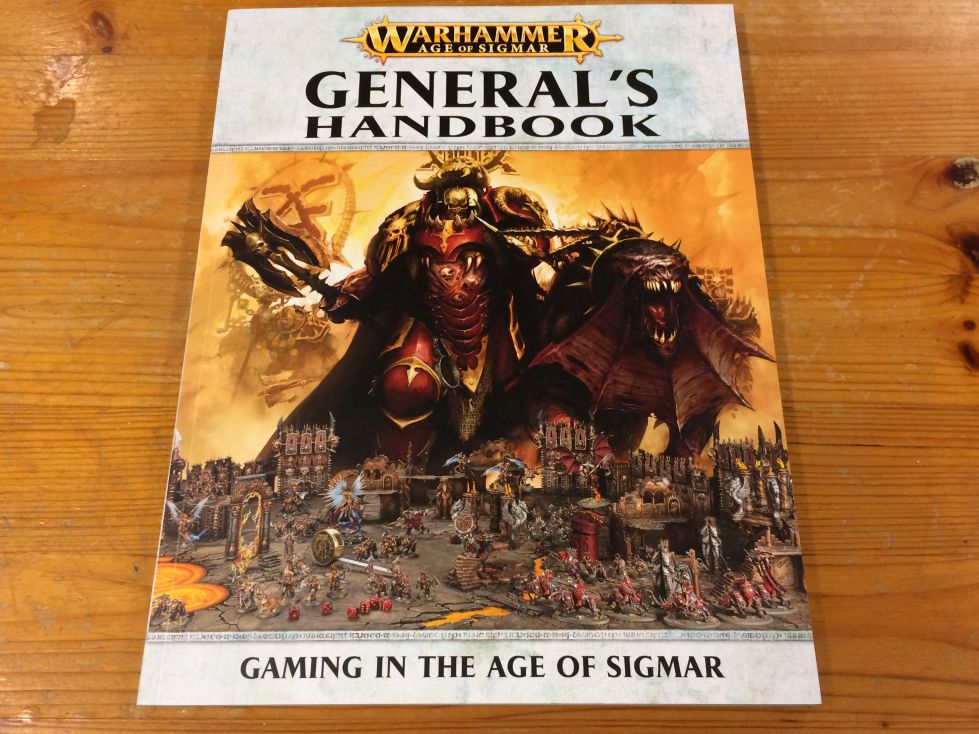
Getting the Point(s) Across
The first half of the book was dedicated primarily to Narrative Play, specifically the debut of Path to Glory, now a staple of AoS. All of the familiar trappings of this style of play were here: Heroic improvement, casualties, and buckets of delicious buffs that let you truly trick out your General. Many factions also had individualized tables and rules for how to progress in Path to Glory, another staple of Narrative Play that’s continued to this day, and I am delighted to inform you that even from the format’s birth, your Slaves to Darkness champion could turn into a gribbly little Spawn.
One major difference in this Handbook compared to newer iterations of Path to Glory is its assumption that you have a full collection — there’s an emphasis on rolling for which units you include, with a matrix of all possible additions, and no mention of traditional armybuilding, instead relying on balancing around the strength of your General. In some sense, this was a smart choice, as a way for players whose complete Fantasy army was languishing on the shelf to experience all of the synergies & combinations in their AoS roster, but this meant that PtG had less initial appeal for new players than it does now. Path to Glory would see a reissue & expansion as its own book in 2017, following its success here, but the fact that General’s Handbook 2016 was essentially split down the middle for Narrative & Competitive players ensured everyone wanted a copy.
While much of the book contained rules for narrative engagements, and campaign play, the back half contained a section aimed at players looking to field genuinely balanced armies, and battleplans primed for competitive play. This was the first time AoS had points associated with its Warscrolls, and moreover, army mechanics for those factions without a Battletome. There was a full 5-round rundown of a ~2000 point game, a specific callout for Tournament Play, and army-wide rules (as well as artefacts & command traits) for each of the Grand Alliances.
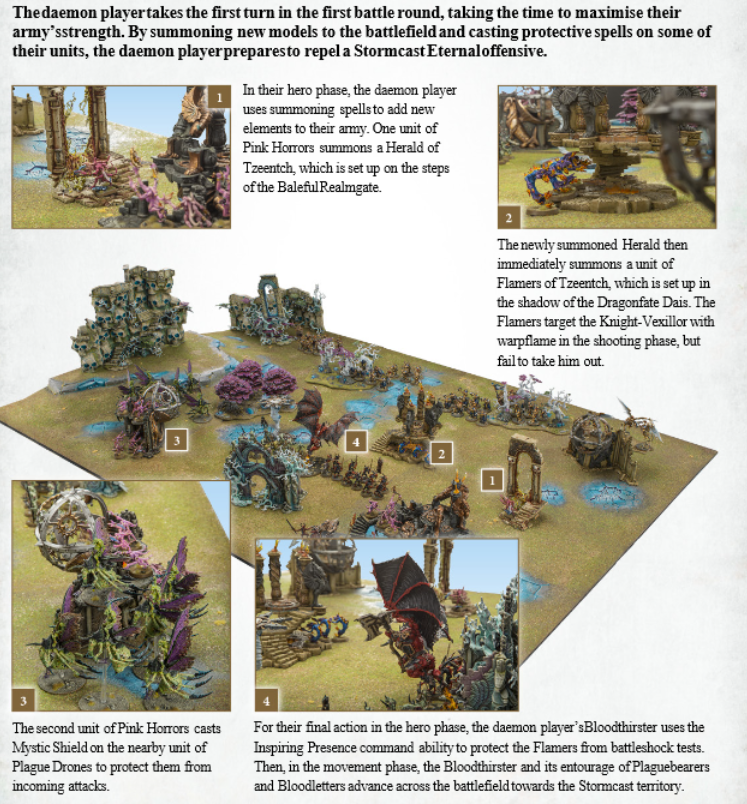
These rules would form the basis of each Alliance’s broad identity, and some mechanics introduced here would persist within AoS, even to this day. For the Alliance abilities, each affected units within a certain distance of one of your Heroes: Order allowed Battleshock rerolls within 12″, Destruction got a D6 move in your Hero Phase within 6″, Chaos could get +1 to hit (on a separate roll of 6+) within 8″, and Death got the very first Ward save in the game as a 6+ within 10″. While many of these traits would be changed or iterated-upon, the faction identities of stalwart Order, charge-centric Destruction, dicey Chaos, and sturdy Death originated here.
It also bears mentioning the inclusion of Warscroll Battalions, something I only briefly touched upon in the previous article. These were AoS’s take on the Formations system from 7th edition 40k, where you could ‘bucket’ several specific units, and pay a small tax, in order to give the units included in that Warscroll Battalion a small or flavorful buff. In each of the Grand Alliance books, many notable Fantasy factions received such groups, which often coincided with the various bundle boxes they would eventually be re-released in. Here, these Battalions were legal for play, although this would slowly be phased out throughout AoS 2.0, mirroring the removal of 7th-style Formations in 40k 8th edition. These are a prevalent yet brief blip in the grand schemes of either system, but it’s noteworthy that their existence was closely tied together, as many aspects between the two larger core games tend to be.
As one can gather, General’s Handbook 2016 is the very bedrock from which all Matched Play in AoS is hewn, which is why I felt going in-depth was warranted. From this point onward, we’d see a massive influx of tournaments being held for the game, as well as posted tournament reports, on top of the formalization of the AoS ITC circuit. Fast forward to September-October 2016, and we’d even have our first ever AoS ITC Champion, Garrett Mulroney, playing a Chaos soup list headlined by Blades of Khorne Heroes. Of course, the game still had a long way to go until it was truly an industry juggernaut, but without the publication of General’s Handbook 2016, the game as we know it truly would not exist.
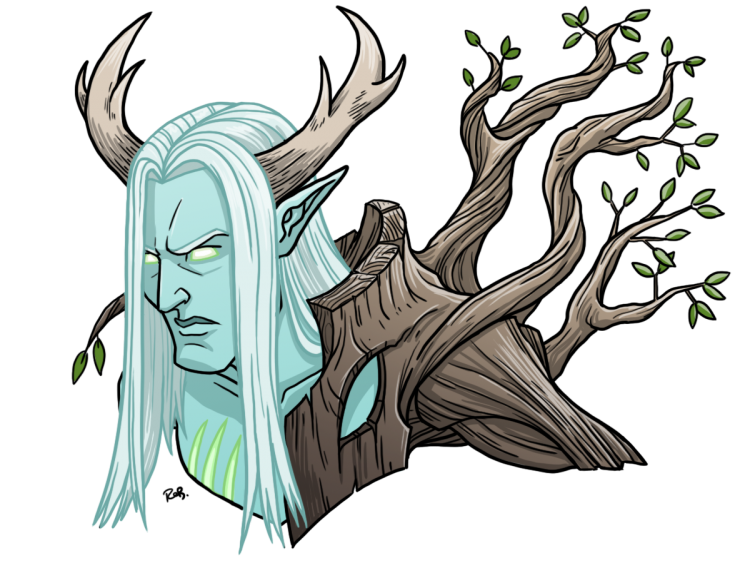
First March of the Ents
July 2nd 2016 saw the release of the largest single wave since the game’s launch, in the form of the Sylvaneth. These spirits of bark and bough were quintessentially AoS, in their high fantasy mystique, and the positivity surrounding their aesthetics & gameplay could not be overstated. This was, in truth, the first real slam dunk when it came to a new faction release; Stormcast & Blades of Khorne were seen as too ‘Warcraft’, Fyreslayers too same-y, and Disciples of Tzeentch were incomplete (originating from a boxed game). Sylvaneth, in stark contrast, hold up remarkably well even compared to modern sculpts. Not only were their centerpieces, Alarielle & Drycha, positively breathtaking, but their various sizes of rank & file, Revenants & Kurnoth, also just felt right. This also played into the previously-released Treelord kit from the tail end of Fantasy, with such an aesthetic cohesion that many today forget they were years apart in release. It’s nearly impossible to find a review of Sylvaneth at this time that failed to echo these positive sentiments.
The one peculiarity of Sylvaneth was that, at the time, they were shockingly underpowered on release, with the glaring exception of Alarielle. The only lists that did well in a tournament setting were paired with a heavy component of Wanderers (Wood Aelves), which had incidental buffs when working alongside Sylvaneth troops. This did not, however, impede the popularity of Sylvaneth a single bit, and many players gravitated towards them as their introduction to Age of Sigmar, a gorgeous entry point to a game that had till then received mostly lukewarm reviews.
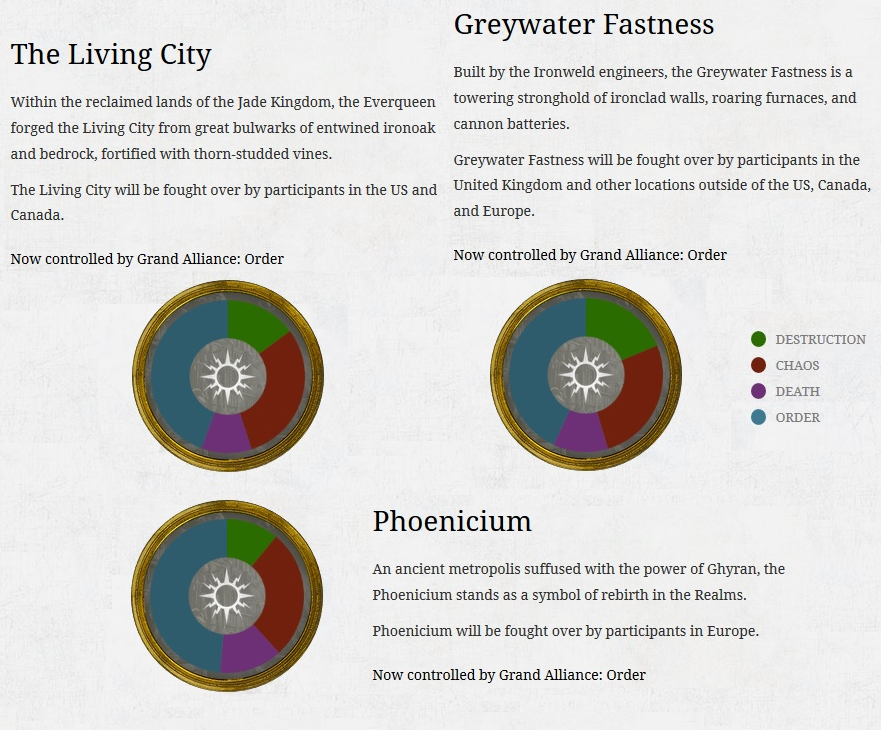
Summer 2016 also included the original Season of War, a worldwide campaign that began on July 14th, cataloging the Grand Alliances’ war in Ghyran, the Realm of Life. This was a marked narrative shift in AoS, being the third realm with a more in-depth exploration after Aqshy at launch, and Chamon in Silver Tower. Here we got a glimpse into three of the Cities of Sigmar, so-called “Seeds of Hope” within Ghyran, being the Phoenicium (A city of Aelves protected by the Phoenix Temples), Greywater Fastness (A city of largely Duardin spitting in the face of Alarielle through gunpowder & industry), and the Living City (A mixed-race city of Order folk living in concert with the Sylvaneth). This campaign concluded with Order holding all three cities, largely bolstered by the aforementioned boom in sales of Sylvaneth specifically.
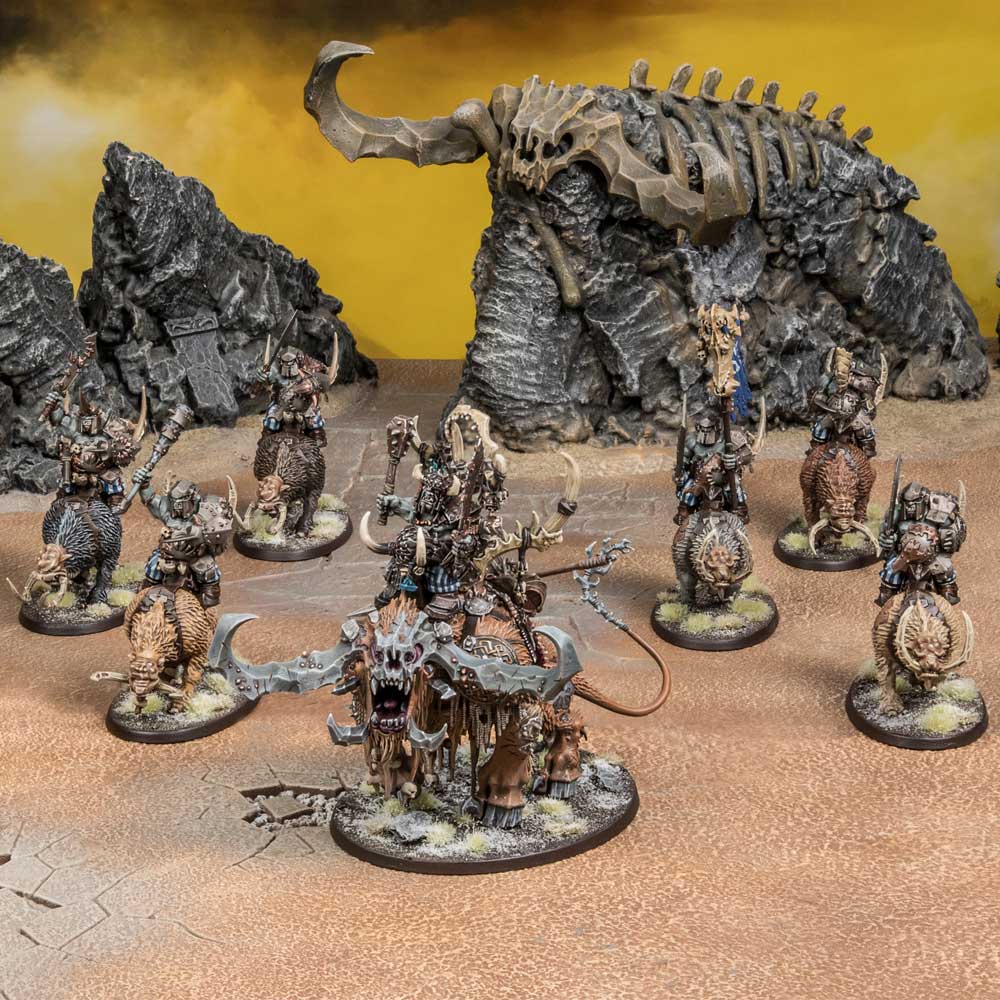
Chilled to the Bone
July 2016 would end with the release of Battletome: Bonesplitterz, as a means to flesh out the lore of these primal Orruks in the Mortal Realms, despite no actual model releases. Here, we’d be introduced to a few of their core gimmicks, Warpaint & Monster Hunters. Monster Hunters applied various buffs when a Bonesplitterz unit killed an enemy Monster, but Warpaint would be the actual standout. Warpaint essentially ‘capped’ your save’s floor at 6+, meaning despite any amount of Rend or Mortal Wounds, a 6 would “somehow save the Orruk from harm”, to quote the tome. We’d see this continue to be an aspect of the army until its squatting this coming edition, although I won’t speculate as to how these poor greenskins might be treated for their last year of legality. What I will say is that, in spite of not receiving any new models or terrain (in contrast to most other releases up until this point), the flavor and gameplay of the Bonesplitterz was still seen as fresh during its release. This did not, however, make it a popular army, although it’s absolutely understandable as to how devoted pilots took this army to tournament tops throughout a huge chunk of AoS 1.0 & 2.0, given the faction was reasonably strong for about half of its total lifespan.

August would see another Battletome release without any new models, in the form of the Beastclaw Raiders. It’s important to remember at this time that there were ~63 factions in AoS, largely split into 1-3 model contingents you were meant to soup together in the form of Grand Alliance battalions, so the factions that got a dedicated Battletome were even fewer & farther between; this was an era where Games Workshop had a vested interest in testing the waters for which sub-groups from Fantasy they could spin off into full AoS factions, like they had with Slayers & Fyreslayers, and Treefolk & Sylvaneth. Here, the Beastclaw Raiders were largely made up of the 2011 Ogre Kingdoms release, including the Thundertusk/Stonehorn, and Mournfangs.
Until the eventual release of the Sons of Behemat, Beastclaw Raiders were the true hyper-elite, “cheap” to collect faction of AoS, being a number of towering glacial behemoths, and their nomadic riders. This introduced us to the concept of the Everwinter, a chilling curse which followed the Raiders throughout the realm, explaining their nomadic culture and cold-worn aesthetics, as well as keeping true to the high fantasy concept of them weaponizing their endless accursed blizzard. These were such a great faction that, even once they were recombined with their Gutbuster brethren, the lore & mechanics first explored here remained fully fleshed-out.

Battletome: Overpriced Terrain
Also released in August (although the book came out in July) would be an oddity for Games Workshop, in the form of Battletome: Dominion of Chaos and its associated terrain. This splatbook sought to provide warscroll abilities for nearly all Games Workshop terrain released up until that point, coinciding with the release of Realm of Battle: Shattered Dominion, the first fully-plastic gameboard themed to Age of Sigmar. Anecdotally, I never played once with a rule offered by this book, and in the minds of my peers whom I’ve asked, remembrance of Dominion of Chaos is hazy at best. This book also contained new Battleplans, each themed around a new terrain piece, such as the Ophidian Archway or Numinous Occulum. This release, and subsequent debuts of more terrain in the form of the Balewind Vortex & Magewrath Throne, would lead to a quiet Quarter 4 for AoS, as 40k received numerous releases during the tail end of its 7th edition.
In this quiet winter season for AoS, we’d see a rise in the tournament scene in Australia & North America, and the Lord-Veritant releasing for Stormcast. This was coupled with a slow uptick in dominance for the Legions of Nagash, the catch-all Death precursor to the Soulblight Gravelords, which were provably dominant in a competitive context, once more players got to grind games in GHB 2016 format. Chaos Soup was also a reasonable choice of army at this time, and Tomb Kings even took a Grand Tournament win in the hands of Tyler Mengel, of Mengel’s Miniatures. Overall, Death was the standout of this first true competitive era of AoS, as every single major faction, as well as Death Soup, saw consistent representation at top tables. I can attest to this personally, as I managed a few solid tournament records myself during this period, with Spirit Host-spam in Nighthaunt.
![]()
Everybody Loves Tzaangor
January 2017 shot off with a bang, being the full release of the Disciples of Tzeentch range for AoS following their debut in The Silver Tower. This included a vast suite of Tzaangor options, such as Enlightened/Skyfires, Tzaangor themselves, and the Shaman, as well as Kairic Acolytes to bolster these mortal forces. On the Daemon front, Blue/Brimstone Horrors were finally back, and the Lord of Change received its modern Greater Daemon sculpt, leaving just the Keeper of Secrets & Great Unclean One in their Fantasy-era pewter. This was also the first-ever iteration of the Destiny/Miracle/Strands mechanic of setting aside dice at some point during the game, in order to use them in place of rolling later on. Not only was this mechanic powerful, it felt extremely good to use, so we’ve seen it repeated a number of times since this debut.
This Battletome would be the most powerful out-the-gate book released in AoS’ history up to that point, and showed either a clear nod towards intended powercreep, or a severe oversight into the strength of Flamers & Pink Horrors. Tzeentch has been a manyfold boogeyman of this game throughout its lifespan, and that began here. 2017 would be the year AoS moved away from Grand Alliance-structured listbuilding, and towards faction-specific armies; Battletome: Disciples of Tzeentch was an unprecedented leap in that direction, and although with the benefit of hindsight we can see the vision that went into this tome’s success, at the time it reigned via an overwhelming contrast to its peers in the system.

Hanniver Toll Hates Tzaangor
To backtrack a bit, despite players beginning to warm up to the mechanics & models of Age of Sigmar, the IP still retained a glaring issue with its perception: Narrative. There were a number of great concepts within the universe, from the Everwinter’s snowy march to the various Mortarchs scheming against Nagash, but not a single novel had yet arrived which understood and communicated why the setting was worth caring about. Things were simply too grandiose & detached during the Realmgate Wars series, and the few surrounding novels & novellas failed to resonate with readers. I bring this up because, on January 14th, 2017, we were introduced to Callis & Toll in Nick Horth’s City of Secrets. This duo would go on to become the modern Gotrek & Felix, as much as any characters might stand on that tallest of narrative podiums, and their banter, and conflicting views on what mortals ought to do within the Mortal Realms is truly fascinating. The compelling, groundfloor look at a single city in the Mortal Realms is a breath of fresh air, and the buddy-cop duo dynamic helps to make the world seem more human, more whole.
Moreover, City of Secrets excels at revealing the best aspect of AoS’s setting — it is patently ridiculous. This glorious fact makes for some wonderful worldbuilding within Excelsis, the city of focus, centralized on its economy of Prophecy, a physical, extractable substance. Not only does the book have great cues for those familiar with the setting (Tzeentch is hinted at throughout before the full might of an Arcanite force emerges), but the book is short, and paced well enough to be an evening’s read for someone looking to introduce themselves to Age of Sigmar. There’s general agreement among the lore-focused within the AoS community that this is where the world’s lore starts to get reasonable, good even, and the fact that it comes coupled with the introduction to characters now purchasable in plastic cements that fact.

The Birds & the Bloods
February 2017 through April 1st, 2017 would see a trickling-out of Battletomes & units for the initial launch factions, being the Stormcast Eternals & Blades of Khorne. These books would be in lockstep with the ethos that drove Battletome: Disciples of Tzeentch, essentially retrofitting their original incarnations with all the power & design cues that had emerged since the flubbed launch of AoS. The Stormcast would see the release of their Vanguard chamber, the rangers & scouts which assisted in exploring the Realms for potential sites of power or safety. Vanguard-Hunters, Palladors, & Aetherwings provided some much-needed mobility to a faction that otherwise had trouble shifting across the board once they came down, as well as potent ranged firepower in the form of Raptors, one of the classic shooty deathstars of AoS 1.0.
Khorne on the other hand received a fully fleshed-out Blood Tithe, stacking points when units died to double Command Abilities, brutalize Wizards, or otherwise propel bloodthirsty marauders up the board. It’s frankly shocking how perfect this mechanic was for Khorne, copying how Khorne Daemons worked in 40k, and some version of it has persisted up through AoS 3.0 with various alterations to the buffs provided by spending Blood Tithe Points. That said, no new models for Khorne in this wave was a strange choice indeed, as Stormcast slowly but surely began to bloat in its model range, being treated like Space Marines, without the broad appeal or distinct chapter structure to justify that many kits. Curiouser still is the fact that, despite nearly all 1.0 “Oldcast” and 2.0 Sacrosanct Stormcast going away, the entire Vanguard range was preserved for 4.0, scraping by despite the culling of golden-armored bloat.
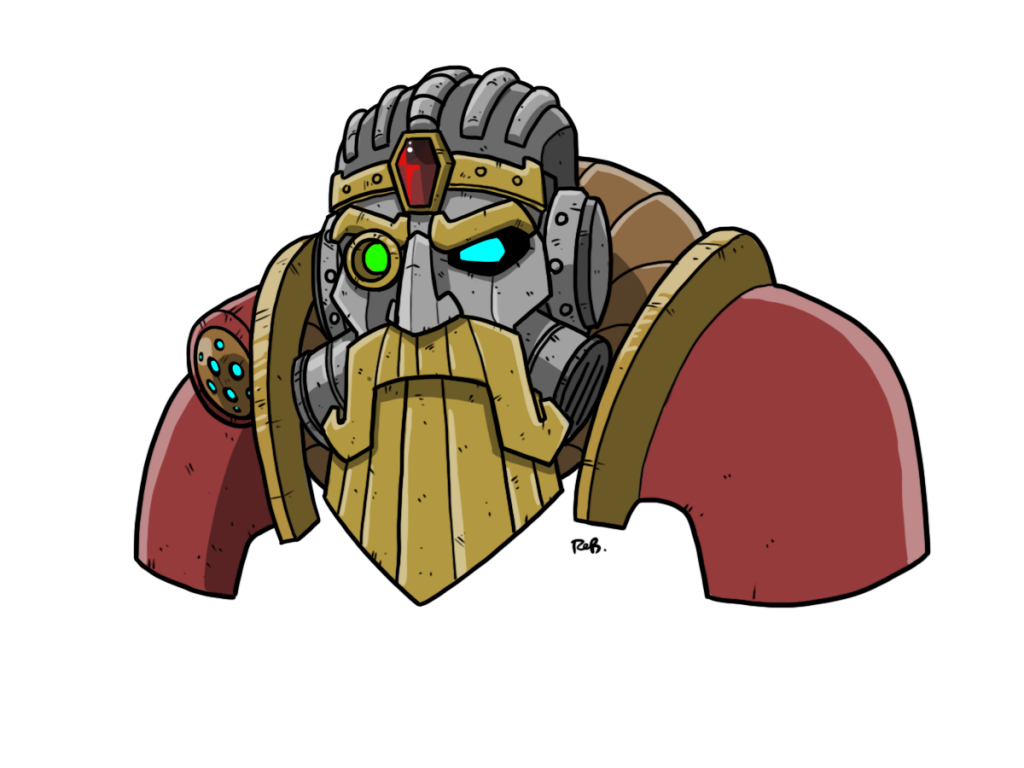
(Steam)punk’s Not Dead
Following immediately after the release of Battletome: Blades of Khorne, April 15th, 2017 parted the skies above the Realms to reveal a brand-new Duardin faction: The Kharadron Overlords. Much like Sylvaneth, the Overlords were a distinctly ‘AoS’ faction, but with absolutely no holdovers from Fantasy, being the first non-launch range wholly unique to Age of Sigmar. They were here to fill several roles, being a gunline in the same vein as T’au, Steampunk in a way Warhammer had never before seen, and filled to bursting with gorgeous centerpieces that made use of the model engineering lessons learned from 40k 7th Edition’s many flying models. It is no coincidence that the first flyer-centric faction in a Warhammer game only came about after 40k had been able to experiment with new airborne kits for each of their factions, as designers will attest.
It should be no surprise that Kharadron was a brass-clad homerun, attracting even more players to Age of Sigmar than Sylvaneth, although it also became the first new range to receive significant backlash; there were many calling it overly modernized, a toe too far into sci-fi within a game squarely sat in high fantasy. These concerns were, however, drowned out by the outpouring of praise for the aeronautical squats. Rules-wise, not unlike Tzeentch, KO was strong. The rules surrounding embarkation into the skyships was messy, and required FAQs, and the ability to shift your firebase across the board at a moment’s notice made the Overlords a faction which quickly earned a reputation for being brutal to play against for those new to the game. While not necessarily as strong as some of the dominant factions in AoS thus far, the skew in winrate between those practiced against the army, and those facing it for the first time, was unhealthy at best.
The Calm Before the Firestorm
Going back through the various first Battletomes for factions post-GHB2016, I’m always shocked to see how developed their identities were, even from the outset, both positive & negative. Khorne playing MSUs to stack Blood Tithe Points, Tzeentch being difficult-to-balance, Kharadron wildly scaling in strength based on their opponent’s experience level — you could make those statements during any period from late 2016 till early 2024, and be spot-on. Of course I’m generalizing a bit, as I can only be so exhaustive, but it’s a magnificent revelation that, in spite of how rough AoS launched, once the designers found their footing, they truly got it.
Further models for the KO range rolled out through late May, as well as a reissue of the original Garden of Morr in the form of the “Sigmarite Mausoleum”, but this period was marked by another lull in releases, due to the 8th edition of Warhammer 40k fast approaching. This was not unexpected, as every time a game’s new edition launches, every other portion of Games Workshop generally takes a backseat to allow hype to center squarely on the title in question. This brief wait would only last until August 2017, leading to a new General’s Handbook, a new and bigger Season of War, and what I would argue to be the best event AoS has ever had: Malign Portents, in January 2018. While this next GHB wouldn’t change as much about the game as the 2016 version, it served as a mini-Battletome for a number of factions, providing the mechanical components of what came in a full tome with none of the fluff. It also served to beckon back towards some of the stranger aspects of 1.0’s early days, such as asking Brayherd players to design their own Herdstone model. That said, we’ll save the final year of AoS 1.0 for next time, with the debut of Underworlds, new Start Collecting! boxes, and of course, Malign Portents.

Next Time: The Malign Portents Era: August 8th, 2017 – June 30th, 2018
That wraps up our second look at Age of Sigmar’s 1st edition! In the final article of this limited series, we’ll look at the strange follow-up to GHB 2016, a brand-new game in the setting, and even more new factions. In the meantime, if you have any questions or feedback, drop us a note in the comments below or email us at contact@goonhammer.com.
